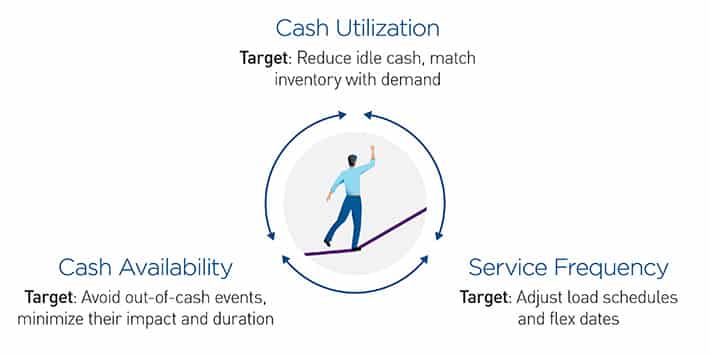The availability of cash at an ATM should go without saying. That’s the advantage of a self-service device, after all; it should be “always on” for each and every customer. Yet, there are cases in which ATMs go out of service. With the right approach, cash management becomes a success. Technical problems may occasionally occur, but downtime due to lack of funds? That shouldn’t ever happen, let alone as frequently as it does at too many financial institutions (FIs).
Most out-of-cash incidents are caused by improper cash planning. How can that be? With today’s data intelligence, there are ways to finally solve this problem once and for all.

Effective tools and services are available to help FIs plan cash needs. Yet, it is not a given that those tools are widely used. This is particularly surprising, not only because the availability of ATMs has a direct impact on customer experience, but because of the fact, that the cost of cash is typically the largest contributor to an ATM fleet’s total cost of ownership (TCO).
Why do so many FIs still use relatively outdated, basic methods, or leave it to unequipped and – already very busy – branch staff to manage a mission as critical as running cash?
Let’s take a closer look.
The cash conundrum: complexity vs. performance
Cash transactions happen en masse every day within both the branch and the self-service network. For each individual cashpoint, the processed volume of cash can vary widely depending on the day, week, month, holiday season and other factors. Obviously, this can easily get complicated.
How much cash should you plan to load, and when, and where? In trying to overcome such difficulties, FIs often take an oversimplified approach that neglects the efficiency aspect: they load more cash than needed, or they monitor thresholds that lead to ad-hoc replenishment and require stand-by cash reserves, or they leave the cash planning with a cash in transit (CIT) vendor who may not offer real optimisation.
While these attempts may help reduce complexity, they do not optimise operational performance.
Effective cash management requires a specially developed, comprehensive, end-to-end solution (software or managed services) that not only delivers a reliable forecast, but also solves conflicting optimisation goals in order to determine the most suitable load amount and the correct service cadence within the given set of business constraints.With the right solution, cash management becomes easy and efficient.
Service frequency: adjust load schedules, flex dates and avoid ad-hoc

Get good data – and use it
It is well-known that good data quality is an essential success factor. It is surprising, therefore, that many FIs still rely on archaic host reports and do little to identify and utilize better data sources for their cash management.
An appropriate monitoring solution should provide an automated data feed with high data granularity (detail) and resolution (frequency). Ideally, all cash inventory is reported by media type, currency, denomination and the role of each individual container, i.e. dispense, deposit, or recycling. Good data resolution means a sufficiently long history and frequent updates of the inventory information. All data should be free of bias and errors.
Cut load cycles
High data quality becomes even more important when cash recycling is used. Why? The principle of recycling is to reuse deposited cash for dispensing, in order to reduce the load frequency. But that capability depends on multiple factors, such as the balance of incoming and outgoing cash flows by face value and retained banknotes, linked to quality and the device configuration. All those variables must be considered in one big equation.
Now, if not before, cash management is truly required. Decision-making support is needed to identify how much cash to load or remove as well as the best cadence in either operations mode, static or dynamic schedules. The concept of fully flexible “just-in-time” schedules has long been known. However, in most parts of the world, CIT vendors continue to prefer static schedules because it makes it easy for them to plan their resources. Of course, this is a major restriction that contradicts a proper demand-based service planning for the individual cashpoint. But with regular review and adjustment of service cycles, a higher level of optimisation is achievable.
Collaborate to uncover additional efficiencies
Even the best software requires experts with process knowledge. This can be a real challenge, especially for smaller FIs. Outsourcing to a recognised managed service provider enables access to resources that may otherwise not be available. Even larger banks are following this trend and relying on specialists to reduce in-house complexity and enjoy rapid return on investment (ROI).
With the right approach cash management becomes a success. Data is used to gain insights, provide decision support, improve resource utilisation, mitigate risk and efficiently meet business needs – all rolled into one comprehensive solution.
By Marco Goltz, Global Head of Cash-Related Services, Diebold Nixdorf

